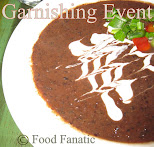Sorry folks for being away for the past few days. It snowed (again!) here and I got pretty sick. I have been living off instant noodles and home delivery during this illness and therefore, no recipes. :( Thanks to everyone who kept checking in despite not being able to find anything new here. I've received an overwhelming response from readers with my efforts on this food blog. For how without my readers would I have had a little less than
850 visitors in no more than
3 weeks?! In this short time, I was also featured by
Kitchen Flavours here. Google Analytics reports that my blog's benchmarking is
way higher than any other blog my size. The average
time spent by visitors on my blog was
7,953.6% higher than visitors on other blogs with comparable size. Page visits were recorded to be a
whopping 233% more than the average! So thank you very much everyone and I look forward to your continued support in...
devouring with me the delicious and myriad flavors of food!

Now getting back to our favorite topic - Food! Being sick just made me just realize that Indian food can typically be so much work. Cooking Indian dishes ideally means starting from scratch. Although frozen vegetables/ cut canned food is available in the market, the dish prepared from those ingredients cannot satiate an Indian's food craving. Who can beat the taste of a dish prepared with fresh ingredients? If you use frozen peas as opposed to fresh peas in an Indian dish, it will make the dish more watery which will dilute the spices and make the food bland. Using fresh vegetables is always good for health reasons, and food prepared with fresh stuff lasts longer. So, it's not about taking the easy or necessarily longer route, it's about quality cooking and focusing on the right approach - smart work versus hard work.
How can we cook fresh food
smartly to make it taste or feel better, last longer, and look prettier without too much of an extra effort? This post is an attempt to share, discuss, and discover some quick tips and tricks for cooking that can help the end product look better, taste better, or feel better without having to add too much of an overhead. Cooking can be an ordeal but when a home made meal turns out good, the effort is all worth it!
Here are some of my ideas to make my dishes look better, feel better, and or taste better.
1.
Pamper the Potato: Potato is a used widely used product in Indian cooking. Typically, I've seen potato being added to a dish to increase the quantity of the dish or to simply add flavor. Lots of Indian street food use potatoes, and some curries are made of a potato base too. Mashed, boiled, deep fried, or baked - Potatoes are good all the way!
But the thing with potatoes is that when left peeled and cut for more than 5 mins, they discolor. This is because the carbohydrates in the potato react with air and undergo the process of oxidation. Discolored potatoes can make your end dish look ugly and more importantly may affect the nutritional value. To prevent potatoes from changing colors, place cut and peeled potatoes in water such that they are fully immersed. When you are ready, drain the water and dump your potatoes in the cooking vessel.
If you want to be able to use freshly cut and peeled potatoes after a day, add lemon juice to the water. This will neutralize the oxidation process.
2.
Boil the Beans: Beans have great nutritional value. To pick the fresh beans, try snapping them from the middle. The ones that snap easily are fresh. Beans are the vegetables that go bad the fastest. I've learned over time that I need to wash them then dry them as soon as I get back from the grocery store and then store them in an air tight zip lock bag before putting them in the crisper in the fridge. This keeps them fresh longer. Another thing I learned while watching the Food Network was to boil beans before stir frying/cooking them. This ensures that the beans don't get overcooked or discolored when stir fried with spices or soy sauce and keeps the nutrients intact.
3.
Overly dry the Okra (or lady finger or bhindi).
Okra is my favorite vegetable. Okra is not widely available in North America and is seasonal. To pick fresh Okras, you can press them between your forefinger and thumb. If it's too soft you know it's rotting. If it's too hard, it won't be edible. To get the freshest Okras, try snapping off the tail of the Okra. The fresh ones snap off easily.
When you cut Okra, it secretes a sticky fluid which makes it hard to handle and makes it look ugly when cooked. To get around this, make sure the Okra is fully dry before cutting.
4.
Retain only the Rice, then rotate it :)
Using a rice cooker is the easiest way to cook rice. However, this is not healthy because the starch gets absorbed by the rice in the cooker. This starch can be fattening. So, the best way to cook rice is to do so in a big pot. Boil water in a pot, then add the rice. Keep checking until the rice is soft and easily breaks when pressed between your thumb and forefinger. When rice is cooked, cover the pot with a steel plate, and drain the water. This eliminates the starch from the rice. But this is risky because the boiling water turned into starch can burn hands. Once you have mastered this technique, you will start loving to eat starch free rice!
Steamed rice looks best fluffy. So don't forget to turn the rice gently when cooked and then leave it covered for 5 minutes. This makes the rice fluffy!
What tips do you have for a fresher, healthier, prettier, happier meal?

 Bonjour! Welcome back to post four of Garnishing tip and techniques for Indian food. It's Spring and the perfect time to try new garnishing adventures in the kitchen. The world around us might still be a little drab right now, but soon it will be bursting into lush and radiant colors. An easy way to kick-start spring indoors is by using vibrant color contrasts on the plate. So here we are today exploring the charisma of contrasting colors in food.
Bonjour! Welcome back to post four of Garnishing tip and techniques for Indian food. It's Spring and the perfect time to try new garnishing adventures in the kitchen. The world around us might still be a little drab right now, but soon it will be bursting into lush and radiant colors. An easy way to kick-start spring indoors is by using vibrant color contrasts on the plate. So here we are today exploring the charisma of contrasting colors in food.










































